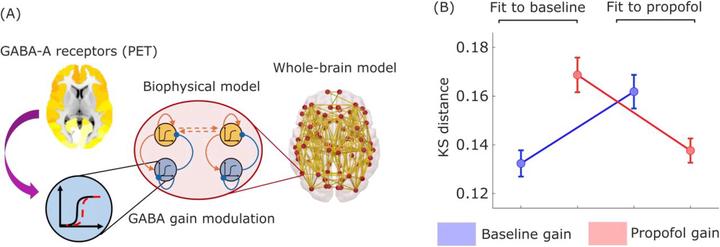
Abstract
The human brain generates a rich repertoire of spatiotemporal dynamics during normal wakefulness, supporting a wide variety of conscious experiences and cognitive functions. However, neural dynamics are reconfigured, in comparable ways, when consciousness is lost either due to anaesthesia or disorders of consciousness (DOC). Here, leveraging a neurobiologically realistic whole-brain computational model informed by functional MRI, diffusion MRI, and PET, we sought to identify the neurobiological mechanisms that explain the common reconfiguration of neural dynamics observed both for transient pharmacological intervention and chronic neuroanatomical injury. Our results show that, by incorporating local inhibitory action through a PET-based GABA receptor density map, our model can reproduce the brain dynamics of subjects undergoing propofol anaesthesia, and that this effect depends specifically on the spatial distribution of GABA receptors across cortical regions. Additionally, using a structural connectome obtained from DOC patients, we demonstrate how the dynamics that characterise loss of consciousness can emerge from changes in neuroanatomical connectivity. Crucially, we find that each of these two interventions generalises across datasets: a model with increased GABA-mediated inhibition can reproduce the dynamics of DOC patients’ brains, and a model with a DOC connectome is also compatible with brain dynamics observed during propofol anaesthesia. These results demonstrate how increased inhibition and connectome randomisation represent different neurobiological paths towards the characteristic dynamics of the unconscious brain. Overall, the present findings begin to disentangle the neurobiological mechanisms by which highly dissimilar perturbations of the brain’s neurodynamics can lead to unconsciousness.